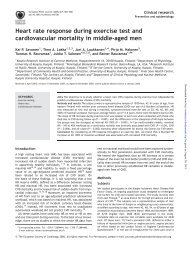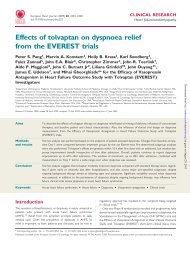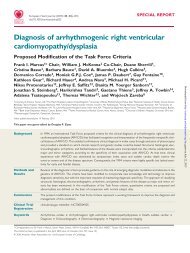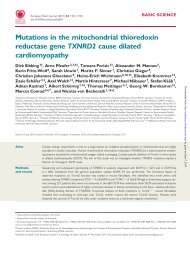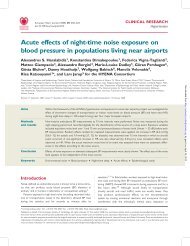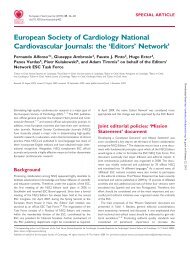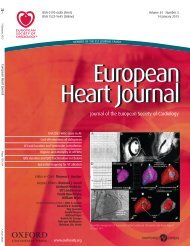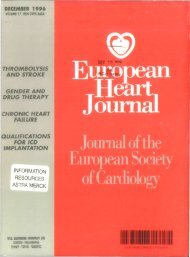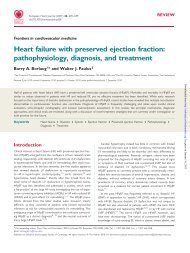Adjunctive manual thrombectomy improves myocardial perfusion ...
Adjunctive manual thrombectomy improves myocardial perfusion ...
Adjunctive manual thrombectomy improves myocardial perfusion ...
You also want an ePaper? Increase the reach of your titles
YUMPU automatically turns print PDFs into web optimized ePapers that Google loves.
3004<br />
Figure 1 Flow diagram of the systematic overview process<br />
(RCT, randomized controlled trials).<br />
Primary endpoint<br />
Data on mortality were available in 2401 (99.4%) out of 2417<br />
patients. As shown in Figure 2, a total of 58 patients (2.4%) died<br />
at 30-day follow-up. <strong>Adjunctive</strong> <strong>manual</strong> <strong>thrombectomy</strong> devices<br />
were associated with significant benefits in terms of 30-day mortality<br />
[1.7 vs. 3.1%, OR (95% CI) ¼ 0.58 (0.34–0.98), P ¼ 0.04,<br />
P het ¼ 0.97]. No potential publication bias was observed by<br />
visual analysis of the funnel plot (Figure 3), and by the mathematical<br />
estimate of the asymmetry of this plot provided by a linear<br />
regression approach. In fact, the intercept of the regression line<br />
did not deviate significantly from zero (a ¼ 20.24, 95% CI<br />
20.58 to 0.33, P ¼ 0.86).<br />
Sensitivity analyses (Table 2) showed that the results were not<br />
influenced by the status of publication, sample size, and study<br />
quality.<br />
Secondary endpoints<br />
Postprocedural thrombolysis in <strong>myocardial</strong> infarction<br />
3 flow<br />
Data on postprocedural TIMI 3 flow were available in 2235 (92.5%)<br />
patients. As depicted in Figure 4, adjunctive <strong>manual</strong> <strong>thrombectomy</strong><br />
devices were associated with a significantly higher rate of postprocedural<br />
TIMI 3 flow [87.2 vs. 81.2%, OR (95% CI) ¼ 1.59<br />
(1.26–2.0), P , 0.0001, Phet ¼ 0.8].<br />
Postprocedural <strong>myocardial</strong> blush grade 3 <strong>perfusion</strong><br />
Data on MBG were available in 2172 patients (89.9%). As depicted<br />
in Figure 5, adjunctive mechanical devices were associated with a<br />
significantly higher rate of postprocedural MBG 3 [52.1 vs.<br />
31.7%, OR ¼ (95% CI) ¼ 2.44 (2.04–2.92), P , 0.0001, P het ¼<br />
0.0003].<br />
Distal embolization<br />
Data on angiographic distal embolization were available in 1207<br />
patients (49.9%). As shown in Figure 6, adjunctive mechanical<br />
devices were associated with a significant reduction in distal<br />
embolization [7.9 vs. 19.5%, OR (95% CI) ¼ 0.30 (0.20–0.44),<br />
P , 0.0001, Phet ¼ 0.24].<br />
Discussion<br />
G. De Luca et al.<br />
The main finding of this meta-analysis is that adjunctive <strong>manual</strong><br />
<strong>thrombectomy</strong> devices are associated with a significant reduction<br />
in 30-day mortality, explained by the significant benefits in epicardial<br />
and <strong>myocardial</strong> <strong>perfusion</strong>, and less distal embolization.<br />
Several randomized trials and a large meta-analysis have shown that<br />
primary PCI provides mortality benefits in comparison with thrombolysis,<br />
mainly due to better and sustained optimal epicardial <strong>perfusion</strong>.<br />
However, despite epicardial recanalization with TIMI 3 flow, suboptimal<br />
<strong>myocardial</strong> <strong>perfusion</strong> may be observed in up to 20–40% of<br />
patients, with a negative impact on long-term survival. 4–5<br />
In addition to microvascular damage, increasing interest, in the<br />
last years, is on distal embolization, 6,46 with several adjunctive<br />
and mechanical therapies being proposed to prevent this complication.<br />
A recent meta-analysis of randomized trials has shown<br />
that adjunctive abciximab administration is associated with a significant<br />
mortality reduction in primary angioplasty for STEMI. 3<br />
Several mechanical devices have been proposed, including distal<br />
or proximal protection devices and <strong>thrombectomy</strong> catheters. 9–40<br />
Recent meta-analyses on these devices 7–8 have shown no benefits<br />
in survival, despite significant benefits in <strong>myocardial</strong> <strong>perfusion</strong> and<br />
distal embolization. However, a trend in mortality benefits was<br />
observed with distal protection devices, whereas a paradoxically<br />
larger mortality was observed with <strong>thrombectomy</strong> devices,<br />
mainly due to the negative results of the AIMI trial conducted<br />
with AngioJet. 15<br />
It must be recognized that <strong>manual</strong> <strong>thrombectomy</strong> devices, by<br />
being inexpensive and user-friendly, represent a very attractive<br />
strategy. This explains the growing interests on these devices<br />
observed in the last years, with several additional randomized<br />
trials being conducted and recently completed. Three trials have<br />
been recently presented at last TCT 2007 held in Washington,<br />
DC, USA, showing benefits in <strong>myocardial</strong> <strong>perfusion</strong> and distal embolization.<br />
35 – 37 Data from the large Thrombus Aspiration during<br />
Primary coronary intervention in Acute <strong>myocardial</strong> infarction<br />
Study (TAPAS) trial have recently been published. 39 In this trial<br />
1072 STEMI patients were randomized before angiography to<br />
<strong>manual</strong> <strong>thrombectomy</strong> (Export catheter) or conventional primary<br />
PCI. The vast majority of patients received Gp IIb–IIIa inhibitors.<br />
This study showed significant benefits in <strong>myocardial</strong> <strong>perfusion</strong> (evaluated<br />
by <strong>myocardial</strong> blush and ST-segment resolution) and a trend<br />
in benefits in 30-day survival. The benefits in <strong>myocardial</strong> <strong>perfusion</strong><br />
were confirmed in almost all the analysed subgroups, even though<br />
larger benefits were intuitively observed especially in patients<br />
revascularized within the first 3 h from symptom onset, when the<br />
amount of <strong>myocardial</strong> salvage is relatively high. One-year follow-up<br />
data have recently been presented at ACC 2008 meeting, 40 showing<br />
significant benefits in survival with <strong>manual</strong> <strong>thrombectomy</strong>.<br />
In our meta-analysis, including nine randomized trials and 2417<br />
patients, we observed that <strong>manual</strong> <strong>thrombectomy</strong> devices were<br />
associated with significant benefits in 30-day survival, explained<br />
by the improvement of epicardial and <strong>myocardial</strong> <strong>perfusion</strong> and<br />
reduction in distal embolization.<br />
Randomized trials conducted so far on mechanical <strong>thrombectomy</strong><br />
devices have failed to show benefits in terms on infarct size<br />
and <strong>myocardial</strong> <strong>perfusion</strong>. Whether the observed benefits in<br />
Downloaded from<br />
http://eurheartj.oxfordjournals.org/ by guest on February 13, 2013



